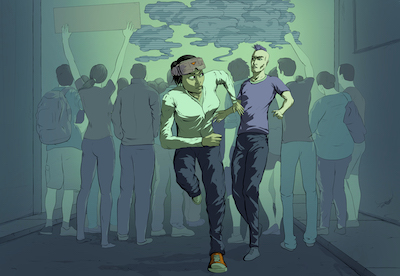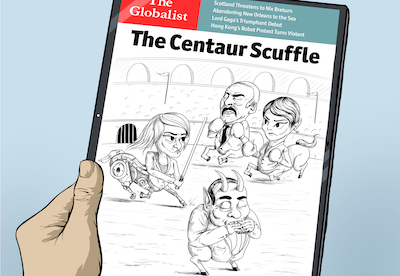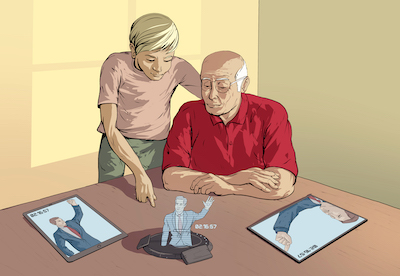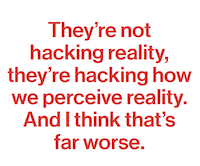Future Now
The IFTF Blog
The Politics of Persuasion
Scenarios from the far future
Whether we know it or not, we are all under constant bombardment by efforts to change our beliefs about the world. Subtle or blatant, obvious or nonsensical, everything, from the typeface and image on the cover of a book to the make-up and clothing on a model to the slanderous lies told about political adversaries, boils down to an intentional act to alter our perceptions in order to elicit a change in behavior. Buy this item. Desire this person. Support this leader.
The tactics of persuasion evolve with our beliefs about the world, becoming more sophisticated as our understanding of the world improves,becoming more brash as our fears about the world surge. The technologies of persuasion evolve along with the tactics, and are used to make a contingent or incomplete vision of the world seem real, even overwhelming. The following three scenarios offer different glimpses of how our methods of persuasion will change as our technologies for understanding and manipulating our reality become more powerful and sophisticated. Can we alter belief by falsifying our perceptions? Can we create the ideal leader through artifice? Can we believe anything we see or hear about the political choices we must make?
Scenario One: Technological Influencers
The Body Politic
 In-person political rallies (“meat-ups,” to the savvy) are hard to beat when you want to demonstrate enthusiasm for a candidate, a party, or a position. You can scam with video and virt, you can overload social media with bots and sock puppets, you can even hack votes. But the on-the-ground presence of a group of people numbering three times the population of Iceland, each of whom has taken time out of their day to support the cause…that’s hard to ignore. And even harder to fake.
In-person political rallies (“meat-ups,” to the savvy) are hard to beat when you want to demonstrate enthusiasm for a candidate, a party, or a position. You can scam with video and virt, you can overload social media with bots and sock puppets, you can even hack votes. But the on-the-ground presence of a group of people numbering three times the population of Iceland, each of whom has taken time out of their day to support the cause…that’s hard to ignore. And even harder to fake.
People still try, and Ri Ri knows that she’s evidence of that effort. She supports Senator Wu, of course, like nearly everyone under 30, although she wouldn’t normally attend something like this rally. She hates coming to downtown Vancouver midweek. Ri Ri knows she should feel excited, since it’s her first Wu event, but her presence is sponsored by TH Ventures. It all feels a bit unseemly, since she is paid to attend, but it does provide a nice bonus on top of her monthly basecoin. Anyway, she’s not alone—Ri Ri figures that at least 10 percent of the people at the rally have some kind of sponsorship deal. That’s politics these days.
Being paid to attend doesn’t help to make the rally more thrilling. The speech is boring, another holo avatar of some dead politician from before persona rights management was a thing. Troo-dow or something. Insisting that only Wu would carry on his legacy. Whatever. He is cute, though. Was.
Like many sponsored attendees, Ri Ri is interested in politics and culture, and does some gig work providing data for journals and researchers. She scans the crowd, both with her own lenses and piggybacking on the public swarm overhead. Transparency laws mean that the signal from the swarm is pretty clean. They also allow Ri Ri to snapshot the crowd. Looks like she can capture about ten thousand people at once. Now, the filtering. First, toss the ghosts, the people attending remotely. That’s a handful, mostly Merkins and Euros, political tourists who have the time and resources to attend things like this around the world. They’re only visible through auglenses, but everybody wears them, so everybody sees them. Erased.
Next, point out the other sponsored people. Can’t make them go away entirely (that whole physical presence thing), but you can change the way they look. Ri Ri’s not all that interested in them, so just desaturate. Boom. A few thousand people suddenly go shades of gray. A couple hundred identify as being from TH Ventures, a few hundred more from the Maple Syndicate, a lot from Googlezon. Okay, now make the activists glow. It’s a bit of a cheat—she can’t actually identify more than a couple dozen registered lobbyists by facial rec, so she uses a proxy. Activists (along with the sponsored) nearly always wear real-time analytic gear, not just home-printed auglenses. Those are relatively easy to spot at a distance. There’s at least a thousand full-timers in the mix, actually a bit fewer than Ri Ri expected. That means that (in this sample anyway) at least two-thirds are honest-to-goodness Interested Citizens. She triggers a capture event of the filtered rally, then puts the video with analytics online. A news aggregator picks it up within a few seconds, depositing a little bit more currency in her wallet. A Wu campaign bot tags it with a Nifty! and another aggregator buys it.
The holo guy is done talking, fading as he walks off the stage to scattered applause. Ri Ri wonders if the Wu campaign will bring out one of those poli-kaiju she’s been reading about—100-metertall holos of the candidate. Started in Japan, no surprise, but really took off in China. Amazingly influential, apparently. Wu’s been relying on the “son of the Chinese diaspora” story, so the political markets are all betting that he’ll start using one by next week.
 Ri Ri is distracted by a small light flashing in the upper-right corner of her lens, alternating green and red. She gestures to it, and she sees that it’s one of the new features in the latest security patch for the analytic software. Ambient biosensors have picked up a rapid microbiome shift in the area. And another, right after that. Wow, that’s blatant. There’s a wave of microbiota coming in over the crowd, able to alter gut and brain chemistry in a way that enhances a willingness to believe. A gullibility front, she’s heard it called. Ri Ri has been putting off the microbiome booster one of her moms keeps pushing her to get, and realizes that she probably has little acquired immunity to the biopolitical message.
Ri Ri is distracted by a small light flashing in the upper-right corner of her lens, alternating green and red. She gestures to it, and she sees that it’s one of the new features in the latest security patch for the analytic software. Ambient biosensors have picked up a rapid microbiome shift in the area. And another, right after that. Wow, that’s blatant. There’s a wave of microbiota coming in over the crowd, able to alter gut and brain chemistry in a way that enhances a willingness to believe. A gullibility front, she’s heard it called. Ri Ri has been putting off the microbiome booster one of her moms keeps pushing her to get, and realizes that she probably has little acquired immunity to the biopolitical message.
Ri Ri starts moving, quickly, towards the edge of the crowd, angling away from the heaviest part of the microbiome front. She’s uploading analytics as fast as she can capture them, and a small bidding war has erupted among the news aggregator bots. As she pushes her way through the mass of tourists, she spots a few more people—sponsored and activist—doing the same. Microbiome-based influencers aren’t illegal, at least not yet, but most people consider them pretty sleazy.
There are no reports about the use of biopolitics in the breaking news stream. As she approaches the edge of the crowd, Ri Ri sees that a single bot has been buying (and overpaying for, really) all of her data. Not a news aggregator, though. Anonymous. She knows it must be the Wu campaign buying it all, but she can’t prove it.
There’s a roar as Wu himself comes on stage, arms held high in a victory pose. Ri Ri keeps one eye on the real-time microbiota map as she works her way towards one of the larger side streets feeding into the park. He starts to speak, and the crowd responds enthusiastically. Of course. From what she’s read, a gullibility microbiome wave won’t change your mind, really, but will make you much more willing to embrace what you already believe. Still, this sucks.
Ri Ri had until now never truly appreciated just how hard-fought political campaigns had become. She’s not sure if she’s happy or sad.
Scenario Two: Digital Candidates
Il Centauro Zuffa
 The Italian news calls it il Centauro Zuffa—“the Centaur Scuffle”—but everyone else just calls it amazing. Five viable candidates for Prime Minister, and not one of them is baseline human. The constitution of the Fourth Republic (est. 2044) explicitly allows for metahuman politicians, a reaction to the previous government’s failure. The Third Republic (2024–2043) collapsed, in large part, because the newly elected Primo Doge was discovered to have had his brain augmented by a powerful digital system, and the Senate refused to let him take office. He was a centaur, in modern parlance, with a mind that had become dependent upon the presence of a machine intelligence. The ensuing controversy led to the collapse of the government.
The Italian news calls it il Centauro Zuffa—“the Centaur Scuffle”—but everyone else just calls it amazing. Five viable candidates for Prime Minister, and not one of them is baseline human. The constitution of the Fourth Republic (est. 2044) explicitly allows for metahuman politicians, a reaction to the previous government’s failure. The Third Republic (2024–2043) collapsed, in large part, because the newly elected Primo Doge was discovered to have had his brain augmented by a powerful digital system, and the Senate refused to let him take office. He was a centaur, in modern parlance, with a mind that had become dependent upon the presence of a machine intelligence. The ensuing controversy led to the collapse of the government.
Now, in the 2044 election, all five of the main candidates are centaurs, to one degree or another. Matteo Stocchetti (who won the previous election despite not being allowed to serve) and Marie Garibaldi are in many ways the least unusual of the group, as both have implanted digital architecture not too different from the wearables and environmental systems in common use, but are otherwise un-augmented. Both seem to use similar (possibly even identical) software to gauge reactions to statements and re-craft their speeches in real time. Too-heavy reliance on the systems had an amusing result in the most recent debate, where the two augmented candidates got locked into a response loop (later parodied as two children yelling “am not!” vs. “are too!”). Although support for the pair dropped considerably after that debate, most simulations, expert systems, and futures markets still have the two neck-and-neck for the lead.
The other candidates are not far behind. Francesco Italia—he renamed himself before the election—runs experimental amalgamation software in his cognitive augment, allowing him to channel the true beliefs and reactions of his growing number of followers. The results have been Startlingly coarse and combative, but Italia's undeniable charm has softened many critics. Now his opponents claim that charm may be a digital construct, too. A new exposé in China Daily asserts that Italia is running Hamlin 0.8, a language and vocal control app designed to boost persuasiveness.
To nobody’s surprise at this point, his Immediate Emotional Response rating among registered voters went up by three points after the revelations. Italian citizens (and most of the world) either hate him with a passion or love him absolutely.
Equally divisive is Silvio Due (also renamed). He calls himself the digital reincarnation of Silvio Berlusconi, the highly controversial Italian leader of the early 21st century. Due is known to use a digital ghost of Berlusconi (based on abundant recordings, speeches, private journals, and, reportedly, a post-mortem brain scan), and claims to have given the ghost full control. He has had cosmetic surgery to make himself look and sound like a somewhat idealized version of the dead politician. Outside observers strongly suspect that there is a consortium of institutional backers supporting Due, as the past five years have seen a resurgence of Berlusconi nostalgia, from serious, high-profile flat films to hagiographic cartoons. As it’s highly unlikely that Due will win, many analysts have concluded that his candidacy is likely a test to see how readily the public in Italy and elsewhere would embrace a digital ghost running for office.
 Paola Rappani rounds out the list of leading candidates. Her augmentations differ from the others in that she uses no software to modify her speeches or responses to questions; instead, she relies on a near-complete replacement of her neural architecture with nanotech neurotransmitter analog cells. These allow her to think significantly faster than a non-augmented person, in ways that aren’t constrained by the limitations of software. With her memory boosted by a full-back nanodigital ink tattoo, Rappani is far and away the smartest person in the race. The enhancements to Rappani’s nervous system have a side-effect of making her speech patterns and physical movements (from how she walks to the movement of her eyes) seem somehow off. One older observer called her “the Uncanny Valley Girl,” and the pun isn’t inappropriate. Many Italian citizens, especially those over 30, find her disturbing in ways they struggle to describe. Younger people, and those citizens in high-empathy careers, find her compelling, and see the difference in behavior not as a flaw, but as an expression of a mind driven to find meaning.
Paola Rappani rounds out the list of leading candidates. Her augmentations differ from the others in that she uses no software to modify her speeches or responses to questions; instead, she relies on a near-complete replacement of her neural architecture with nanotech neurotransmitter analog cells. These allow her to think significantly faster than a non-augmented person, in ways that aren’t constrained by the limitations of software. With her memory boosted by a full-back nanodigital ink tattoo, Rappani is far and away the smartest person in the race. The enhancements to Rappani’s nervous system have a side-effect of making her speech patterns and physical movements (from how she walks to the movement of her eyes) seem somehow off. One older observer called her “the Uncanny Valley Girl,” and the pun isn’t inappropriate. Many Italian citizens, especially those over 30, find her disturbing in ways they struggle to describe. Younger people, and those citizens in high-empathy careers, find her compelling, and see the difference in behavior not as a flaw, but as an expression of a mind driven to find meaning.
But even Rappani’s augmentations can’t hide a rising frustration with the nature of modern politics. More and more citizens have come to realize that most candidates for political leadership can offer little in terms of knowledge, insight, or even charisma that the citizens themselves couldn’t provide, as long as they have the right technology. This has had two significant results.
Firstly, this perspective has motivated many citizens to seek candidates who offer something beyond the digitally replicable: emotional awareness, humor, even flirtatiousness. The power of digital augmentation creates a greater need for human qualities.
Secondly, by democratizing the artifacts of power and leadership, we demystify them. Political figures no longer seem exceptional, and a growing number of academic expert systems have started to call for replacing voting-based democracy with a simple leadership lottery, arguing that if there’s no real difference in capability between voter and candidate, we would be better-served by a wider array of backgrounds and experiences in our leaders.
Until then, however, Italy’s “Centaur Scuffle” will be watched in horror and fascination around the world. Few nations explicitly allow cognition-augmented individuals in higher office, fearing the potential for hacks, software errors, even viruses. The next leader of Italy, whomever he or she will be, will offer a real-world beta test of whether the combination of human mind and machine mind can lead the world into a better future.
Scenario Three: Digital Voters
Rashômon
 I usually don’t tell people this, but my grandson Andrei actually decided my vote in the last two big elections. He’s 17 now, almost of age to vote for himself. I’ve been having him do this for me since he was 13. It’s not that I don’t care about who wins elections, I do. It’s just that, firstly, he has more future at stake than I do. And, secondly, he can sort through the noise and hoaxes and lies so much better than I can.
I usually don’t tell people this, but my grandson Andrei actually decided my vote in the last two big elections. He’s 17 now, almost of age to vote for himself. I’ve been having him do this for me since he was 13. It’s not that I don’t care about who wins elections, I do. It’s just that, firstly, he has more future at stake than I do. And, secondly, he can sort through the noise and hoaxes and lies so much better than I can.
It started back in 2040, when the “Just Kill Them” video hit the net. It was a personal headware video of President Peter Verkovenski talking at a private meeting of donors in a fancy Saint Petersburg hotel. Like most headware recordings, the image is jumpy and the sound is a bit off, but the recording was clear enough: President Verkovenski discussing the latest eruption of the Chechen Problem, declaring that, once re-elected, his policy would be simple: just kill them. The audience murmurs in surprise, then offers loud applause, and the video cuts off.
Verkovenski’s campaign immediately denied that he had said anything so shocking, even as Nicola Stavrogina’s campaign pushed to make the recording the top story of the election. Verkovenski himself categorically rejected the video, calling it a snake pit of lies, even going so far as to release an internal video of the event (at a different angle, taken by a high-end threevee camera) showing that what he actually said was that his policy would be one of increased autonomy, leading to possible statehood. As this would be a dramatic shift from previous policy, the initial public response was to reject Verkovenski’s recording and embrace the headware video. Verkovenski eventually won, but only by the slimmest of margins.
My 13-year-old grandson, upon seeing the Verkovenski campaign’s recording of the event for the first time, said “oh, they finally released the real one!” Apparently, most of his peer group had known the headware video was a hoax from the outset. He pointed out some image artifacts and edits typical of hoaxed headware video; he demonstrated how readily this is done by sending me his own version of the headware recording, now showing President Verkovenski arguing forcefully that the Chechens were known to be Lizard People from Alpha Centauri, and that we must worship them. “It’s been easy to do this for years.”
Since then, Andrei has been educating me in the ways of modern political campaigns. How to spot manipulated videos/threevee recordings, for example: never trust a single recording; the greater the quantity and diversity of recordings (position, recording medium, source), the more trustworthy. Certain phrases and words are harder to manipulate properly, so look to see if the speaker’s mouth is obscured when the words appear. Does the body language match what’s being said? Inconsistent exposure, shadows, focal length. Andrei calls it “building up your immune system.”
It’s not just video. Together we looked at the software that offers to determine voting choices and outcomes. There are the whispertruth apps that verify or refute candidate statements as they’re said. Election simulations allowing you to alter turnout, demographics, scandals. Voting guides that take your beliefs, experiences, interests and tell you which candidate is the best fit. “None of this is objective,” he said. “It’s more a matter of deciding which biases you’re willing to ignore.”
 He said that his older peers tend to pull together a wide assortment of these apps to try to find the obvious outliers and the consistent responses. They call it “goulashing” (he didn’t know why,I had to tell him that goulash was a kind of food that mixes a bunch of different ingredients). For some goulashers, the goal is to find the closest to non-partisan results they can generate; for others, it’s to see what happens when you throw together the most outrageously diverse elements, like pairing extreme religious politics simulations from America and Pakistan, then adding sims from the Icelandic Pirate Party and an environmental group called Earth First.
He said that his older peers tend to pull together a wide assortment of these apps to try to find the obvious outliers and the consistent responses. They call it “goulashing” (he didn’t know why,I had to tell him that goulash was a kind of food that mixes a bunch of different ingredients). For some goulashers, the goal is to find the closest to non-partisan results they can generate; for others, it’s to see what happens when you throw together the most outrageously diverse elements, like pairing extreme religious politics simulations from America and Pakistan, then adding sims from the Icelandic Pirate Party and an environmental group called Earth First.
This year’s election is different, though. President Verkovenski still has another two years in office, but there’s a digital campaign against him that even Andrei and his friends can’t figure out. Two dozen sets of recordings, both threevee and headware, have been released showing the President giving speeches around Russia that he claims he never gave. The various recordings are all from different angles. The speeches all match Verkovenski’s policies, and are convincingly in his voice and style. In many ways, from eloquence to the wisdom of the policies, these false speeches are improvements upon the reality. But there’s no other evidence of these talks and, indeed, no audience members from these supposed speeches have come forward. Jokes about twins, clones, and holograms abound, yet nobody can figure out why someone would go through this effort to create such an elaborate hoax.
I have my suspicions. I spoke about it with one of Andrei’s older friends, Natasha, this morning. “We knew that digital voting systems could be hacked, were hacked, and so we did something about it. We can trust the voting machines, we have transparency,” she said. “Now they go after how we decide. They aren’t hacking the final voting decision we make, they’re hacking how we come to the decision in the first place. They’re not hacking reality, they’re hacking how we perceive reality. And I think that’s far worse.”
I smiled at her, as I’m old enough that I can recall the dying days of the old Soviet Union, and later the rise of what Americans delightfully called “post-truth politics.” “That has always been the point, to alter our perceptions of reality,” I told her. “Now, they are turning their weapons upon themselves. The hoaxers are showing Verkovenski what he could do if he were better, smarter, wiser. Hacking his perception, showing him a reality where he is everything he has failed to be in the here and now. Our leaders forced us to build up our immune systems, but they forgot to build up their own.”
 FUTURE NOW—When Everything is Media
FUTURE NOW—When Everything is Media
In this second volume of Future Now, IFTF's print magazine powered by our Future 50 partnership, we explore the future of communications, tracing historical technology shifts through the present and focusing on the question: “What is beyond social media?”
Think of Future Now as a book of provocations; it reflects the curiosity and diversity of futures thinking across IFTF and our network of collaborators. This issue contains expert interviews, profiles and analyses of what today’s technologies tell us about the next decade, as well as comics and science fiction stories that help us imagine what 2026 (and beyond) might look and feel like.
About IFTF's Future 50
Every successful strategy begins with an insight about the future. Every organization needs to build the capacity to anticipate the future. The Future 50 is a side-by-side relationship with Institute for the Future; it’s a partnership focused on strategic foresight on a ten-year time horizon. With 50 years of futures research in society, technology, health, the economy, and the environment, IFTF has the perspectives, networks, signals, and tools to make sense out of the emerging future.
For More Information
For more information on IFTF's Future 50 Partnership and Tech Futures Lab, contact:
Sean Ness | sness@iftf.org | 650.233.9517



